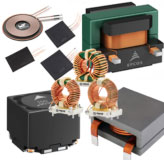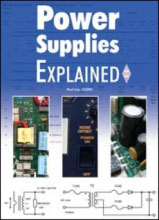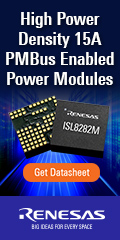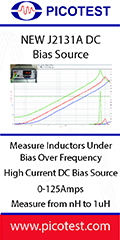 |
|
IN THIS ISSUE:
» The Power Supply Designer’s Guide To Radiation Effects in Power Semiconductors
» How Application-Driven Performance And Reliability Requirements Shape Design and Qualification Of GaN Power Devices
» The Engineer’s Guide To EMI In DC-DC Converters (Part 13): Predicting the Common-Mode Conducted Noise Spectrum
» Focus On Magnetics:
Power Magnetics Component Roundup
» Spotlight On Safety & Compliance:
Power Supply Book Also Explains EMI And EMC Requirements
» New Power Products
» Other Top Power News
From the Editor's Desk David G. Morrison
Editor, HOW2POWER TODAY

SpaceX recently ushered in a new era of spaceflight with its launch of two NASA astronauts aboard its Crew Dragon capsule, propelled by its Falcon 9 rocket, on a mission to the International Space Station. Humbly dubbed the Demo 2 mission, this flight was SpaceX’s first crewed launch, the first time a commercially built spacecraft has delivered astronauts to the space station, and more broadly, the first commercially built rocket to launch people, rather than satellites or other cargo, into earth orbit. As such, Demo 2 represents another in a long line of firsts for the commercial spaceflight industry, which is making access to space less costly and more commonplace for man and machine. Witness the ongoing proliferation of satellites, especially small satellites in low earth orbits, which are expanding communications and various kinds of data collection. As these and other forays into space expand, the demand for space-grade power components will also grow, driving development of new and better radiation hardened and radiation tolerant power semiconductors. However, for the uninitiated, the rad hard component world can be a mysterious place full of unfamiliar specifications and sticker shock pricing. In his feature on radiation effects in power semiconductors, Paul Schimel aims to demystify the topic for power system designers, explaining the various ways in which charged particles can bombard and damage different power semiconductor structures, the tests performed to gauge a component’s vulnerabilities to these effects, and other design issues. This newsletter presents another article discussing semiconductor device reliability—Sam Abdel-Rahman and Deepak Veereddy’s feature on GaN power devices. Plus we have Tim Hegarty’s next installment on EMI in dc-dc converters, explaining how to predict common-mode noise; a book review discussing EMI issues; a roundup of recently introduced magnetic components and more.
|
|

 |
 |

|
HOW2POWER EXCLUSIVE DESIGN ARTICLES 
|
The Power Supply Designer’s Guide To Radiation Effects in Power Semiconductors
by Paul L. Schimel, Microchip Technology, Chicago, Ill.
Let’s pretend that in a parallel universe our predecessors who knew the ins and outs of radiation hardened semiconductors retired, but left no succession plan. New engineers would have a lot of questions and no answers, as would tenured staffers. Not that any of this would be possible in our universe. But if it were, maybe the brief ramblings to follow would help fill that cosmic gap and offer a bit of utility. So why is radiation hardened needed? What of the fundamentals of radiation hardness? How do you design for this? How can a 2N2222A be $0.60 in single pieces while a JANSR2N2222A is $165.00? What do these things do and how do they work? How are they tested and validated? These are the types of questions this article will answer.
Read the article…
|

Various types of tests are required to
gauge a rad hard semiconductor’s ability
to withstand radiation effects such as
SEE, TID, ELDRS, LET, SEB, and SEGR. |

|

Among the differences in GaN versus
Si failure modes, avalanche failure
resistance is significantly higher in
GaN than in Si, and for GaN, this
failure mode is a function both of
thermal limits and time-dependent
dielectric breakdown. |
How Application-Driven Performance And Reliability Requirements Shape Design and Qualification Of GaN Power Devices
by Sam Abdel-Rahman and Deepak Veereddy, Infineon Technologies, El Segundo, Calif.
The structures of GaN devices and their operating mechanisms differ from those of the more familiar silicon (Si) power MOSFETs. These differences account for the performance advantages of the GaN transistors, but also impose different gate-drive requirements and imply different failure mechanisms. This article describes how GaN power transistors differ in structure and performance from their Si counterparts, the different approaches to achieving normally off operation, gate structures used to design enhancement-mode GaN power transistors and gate-drive requirements, particularly as they relate to Infineon’s CoolGaN devices. The last part of this article describes the extensive tests conducted by Infineon to confirm the robustness of the gate structure and to qualify these new devices for in-field applications, particularly telecom power supplies which represent the most stringent requirements.
Read the article…
|


The Engineer’s Guide To EMI In DC-DC Converters (Part 13): Predicting the Common-Mode Conducted Noise Spectrum
by Timothy Hegarty, Texas Instruments, Phoenix, Ariz.
Part 1 of this article series reviewed the applicable EMI standards and measurement approaches for conducted and radiated interference from dc-dc converters. Part 2 then studied the noise propagation and separation of differential-mode (DM) and common-mode (CM) currents to understand the requisite attenuation from the EMI filter. More recently, part 12 reviewed the DM noise spectrum and streamlined models to predict it, at least from a low-frequency standpoint as it pertains to DM filter design. The analysis considered the converter and passive EMI filter stage as well as the measurement equipment, specifically the line impedance stabilization network (LISN) and the EMI test receiver. Part 13 now takes a similar approach for the CM conducted noise spectrum, again referring to the behaviors of the converter, the passive EMI filter and the LISN.
Read the article…
|

The frequency response of an equivalent
CM input filter including higher-order
resonances related to the filter component
self-parasitic elements. |


FOCUS ON MAGNETICS 
Sponsored by Payton Planar Magnetics
A monthly column presenting information on power magnetics design, products, or related technology |

Power Magnetics Component Roundup
by David G. Morrison, Editor, How2Power.com
This article presents information on power inductors, transformers, chokes and other magnetic components for power supply applications, covering products introduced over the past six months. Some related products such as a vendor design tool and a magnetics-related white paper are also included. As in past roundups, power inductor announcements dominate the news with manufacturers adding to their portfolios of inductors featuring shielding, low dc resistance, high current ratings, high temperature rating, and small size. Some of the newer devices specify high operating voltage as well. This article also carries news of specialized transformers such as flyback and current sense, chokes and beads for filtering and noise suppression, and some wireless power coils.
Read the full article…
|

|

 |
 |

SPOTLIGHT ON SAFETY & COMPLIANCE 
Sponsored by Power Integrations
A monthly column discussing standards and regulatory requirements affecting power electronics |

Power Supply Book Also Explains EMI And EMC Requirements
Power Supplies Explained, Paul Lee, G3ZKO, published by the Radio Society of Great Britain, September 11, 2018, 531 pages, $24.95 from ARRL, also available for Kindle from Amazon.
Reviewed by Kevin Parmenter, Chair, and James Spangler, Co-chair, PSMA Safety and Compliance Committee
Paul Lee’s very practical book on the broader subject of power supplies also contains very useful information on EMI and EMC. “Power Supplies Explained” provides explanations on the causes of electromagnetic interference in its various forms, techniques for identifying and mitigating the sources of EMI, applicable regulations, and other details that can help working engineers get their products to market faster. In his review of the chapter on EMI and EMC, Kevin recaps what readers can learn from this discussion while also sharing his experiences in getting power converters to pass regulatory requirements.
Read the full article…
|

|

 |
 |

 — POWER PRODUCTS IN 3 IMAGES OR LESS — POWER PRODUCTS IN 3 IMAGES OR LESS 
|


Christophe Basso’s power supply
circuits for SIMPLIS. |
Free Power Supply Circuits For SIMPLIS Offer Ready-Made Design Templates
 List: In preparing his soon-to-be released book on small-signal modeling of power converters, Christophe Basso has developed SIMPLIS simulation files for a wide range of switched-mode power converters. Most of these 63 ready-to-simulate power converter circuits will run in Elements, the free demo version of the simulator. List: In preparing his soon-to-be released book on small-signal modeling of power converters, Christophe Basso has developed SIMPLIS simulation files for a wide range of switched-mode power converters. Most of these 63 ready-to-simulate power converter circuits will run in Elements, the free demo version of the simulator.
 Diagram: Example circuit template for a fixed-frequency current-mode-controlled flyback converter with simulations of transient response and Bode plots of gain and phase. Diagram: Example circuit template for a fixed-frequency current-mode-controlled flyback converter with simulations of transient response and Bode plots of gain and phase.
See the full story…
|


 |

|


Riedon’s SSA Smart Shunt series
modules. |
Isolated Shunt Modules Challenge Hall Sensors In High-Power Current Sensing Applications
 Photo And Diagram: The current-sensing module combines a shunt resistor with a precision isolation amplifier and signal conditioning circuitry, providing a signal that can be fed to an external ADC. Photo And Diagram: The current-sensing module combines a shunt resistor with a precision isolation amplifier and signal conditioning circuitry, providing a signal that can be fed to an external ADC.
 Chart: The module outperforms Hall Effect current sensors with respect to weight, electrical accuracy and stability, and cost. Chart: The module outperforms Hall Effect current sensors with respect to weight, electrical accuracy and stability, and cost.
See the full story…
|

Nexperia’s GAN041-650WSB and
GAN039-650NTB/NBB GaN FETs.
|
Second-Gen Technology Boosts Performance Of 650-V GaN FET Devices
 Photo: After releasing a 50-mΩ, 650-V, GaN power device in the TO-247 last year, the company has leveraged its new H2 GaN HEMT technology to produce a 41-mΩ device. Putting the same new die into the company’s copper-clip surface-mount package reduces on-resistance even further, down to 39 mΩ. The latter also offers top- and bottom-side cooling options. Photo: After releasing a 50-mΩ, 650-V, GaN power device in the TO-247 last year, the company has leveraged its new H2 GaN HEMT technology to produce a 41-mΩ device. Putting the same new die into the company’s copper-clip surface-mount package reduces on-resistance even further, down to 39 mΩ. The latter also offers top- and bottom-side cooling options.
See the full story…
|

 |

|

ROHM Semiconductor’s
BD18336NUF-M LED driver IC.
|
Automotive LED Driver Ensures Stable Lighting During Battery Voltage Drops
 Diagram and graph: The LED driver is said to be the first single-chip IC to incorporate a current bypass function that enables stable lighting during battery voltage drops. When voltage drops occur, the path for LED lighting can be smoothly switched from three lights to two lights without flickering. Diagram and graph: The LED driver is said to be the first single-chip IC to incorporate a current bypass function that enables stable lighting during battery voltage drops. When voltage drops occur, the path for LED lighting can be smoothly switched from three lights to two lights without flickering.
 Drawing: Ensuring stable lighting while enabling mounting on a 100-mm2 substrate makes it possible to achieve ultra-compact socket-type LED lamps. Drawing: Ensuring stable lighting while enabling mounting on a 100-mm2 substrate makes it possible to achieve ultra-compact socket-type LED lamps.
See the full story…
|


|










|
OTHER TOP POWER NEWS
|
|
 Radiation Test Solutions has reached an agreement with Cobham Advanced Electronic Solutions to purchase Cobham RAD, a provider of MIL-STD radiation effects test services, heavy ion SEE testing, device preparation service prior to test, device screening and element evaluation, and quick turn prototype integrated circuit assembly. Radiation Test Solutions has reached an agreement with Cobham Advanced Electronic Solutions to purchase Cobham RAD, a provider of MIL-STD radiation effects test services, heavy ion SEE testing, device preparation service prior to test, device screening and element evaluation, and quick turn prototype integrated circuit assembly.
 CCell Renewables, a marine engineering company, is using an innovative power delivery system from Vicor to power new coral reef growth to save coastlines and protect communities. CCell Renewables, a marine engineering company, is using an innovative power delivery system from Vicor to power new coral reef growth to save coastlines and protect communities.



 As a result of a recently signed development partnership, ROHM Semiconductor will provide proprietary SiC technology optimized for Vitesco Technologies’ high-voltage power electronics for electric vehicles. As a result of a recently signed development partnership, ROHM Semiconductor will provide proprietary SiC technology optimized for Vitesco Technologies’ high-voltage power electronics for electric vehicles.
 The Power Sources Manufacturers Association is opening both their Safety & Compliance Standards Database and their Energy Efficiency Regulations Database to the public with no sign-up required. The Power Sources Manufacturers Association is opening both their Safety & Compliance Standards Database and their Energy Efficiency Regulations Database to the public with no sign-up required.



 TDK-Lambda Americas has launched an upgraded website, combining ac-dc, dc-dc, programmable, high-voltage and power supply accessories in one location, which can be accessed using smartphones, tablets and other mobile devices without any loss of functionality. TDK-Lambda Americas has launched an upgraded website, combining ac-dc, dc-dc, programmable, high-voltage and power supply accessories in one location, which can be accessed using smartphones, tablets and other mobile devices without any loss of functionality.


|

ABOUT THIS NEWSLETTER: Thank you for reading HOW2POWER TODAY.
How2Power sends no more than one e-mail per month to registered users. Continuing your subscription ensures you'll receive future newsletters. Manage Your Subscription
©2020 All rights reserved. www.how2power.com
|
|